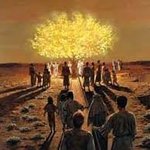Restore the Ancient Wisdom with the Tree of Life

KONA, HAWAII – All around the Earth at this time of year the Tree of Life is renewed in ceremonies, services, parties, and candle-lightings. When people come together to celebrate the longest night of the year, we share the message of this joyful time, which is to love one another.
We celebrate the return of the sun – the birth of the son — with merry singing and dancing. Kwanzaa, Christmas, the ancient festivals of Europe, Africa, Asia, and the Americas, as well as the modern e-bay and shopping mall rush to find last-minute presents (presence), are rites of passage.
Nourishing the Tree of Life, Yuletide, Saturnalia, the Long Night, the Festival of Lights, Hanukah, and the Feast of Dedication, all aim to satisfy the human longing to see and feel through the prism light of love.
The faithful, the artful, the strong, the meek, the children, the grandparents, aunties and uncles everywhere remember to lift their own and others’ spirits. Together, we rise.
Even if we don’t always feel connected and a part of it, even if we are alone in a room, we are still one human family remembering itself, quickening in the blood consciousness, taking part in a global dance of renewal that goes back at least as far as when our bony-fin ancestors climbed out of the primordial sea to land.
The renewal of life doesn’t always mean “togetherness.” Especially when we feel vulnerable and confused, we can remember our brave ancestors who must have early on crawled into caves and worried the light would not return. During the long dark nights in their sinuous grottoes, they must have learned to trust, to believe, to draw on the rhythms of nature to renew themselves.
Daylight finally came, and lengthened into springtime, the joy of new life. I feel closer to them knowing how awesome it must have been to first appreciate the infinite generosity of a sun that did not let them down, and to think, no matter what darkness brought, “This too shall pass.”
They learned to emulate the bounty of the sun, to live by the chalice of worship, rather than the blade of war. They made offerings to life by honoring the four directions, the natural cycles, the freshness and continuing goodness of abundance, good cheer, and good health. They gave to nature and each other the endless treasures of love and creativity that filled their hearts.
They ruled their land wisely, and each spring they would feel reborn as they celebrated with the flowers in the field. They would dance and sing ecstatically to feel nature’s power. Without fail, they created rituals of gratitude and sharing, and at the time of seeding they planted green and golden seeds into the soil, working together in joy and mutual respect. At the time of harvest, they came together to fill their storerooms with the gifts of nature, to celebrate their great good fortune.
People also knew that every year, without fail, as the Sun entered the sign of Capricorn, its rays would become weaker and weaker. Coldness and darkness would embrace every village in this beautiful land.
Every single warrior, hero, healer, artist, dancer, musician, child, grandparent, and mother and father would fall under the spell of this season of stillness. Everyone would feel their energy drop, their limbs become heavy, their desires drop and in the long winter nights, they felt caught in the frozen air, with snow flakes falling slowly and gently over their houses and fields.
The contracting energy of winter often made them want to retreat in their warm beds under their comfortable blankets, to surrender like bears to lassitude for the whole of the winter period.
But there were certain people in this distant time, people very like Hawaiian Kupuna and Kahuna, Native American Shaman, Priests, Priestesses, Medicine Men and Women, Ministers, those wise Leaders who are in contact with the divine. These sages knew when the time for a ritual came. They would sit in silence, keep away from the village’s activities, and after some calculations, announce the favorable date in which a ritual could be performed for the good of all. These matriarchs and ministers, grandfathers and group leaders, knew many rituals that brought health, happiness, and abundance to their ohana, the family and community.
They knew how to expel the bad spirits of suffering and poverty, conflict and disease, and also how to invite good spirits into the body, to repel disease. They had special rituals for celebrating birthdays, for welcoming the Full Moon, for celebrating the beginning of spring, and for honoring the Tree of Life.
So when winter engulfed the Earth in its cold and dark embrace, and people might feel withdrawn or depressed, wanting to hibernate, the shaman would call everyone in the family, clan, or community together to perform a great ritual.
They gathered around the Tree of Life for a ritual meant to increase their energy. Every man, woman and child, every warrior and hero of the land, was invited to place something dear to them on the tree.
“This should not be casual,” said the sage shaman. “Every object you give should have a special meaning for you: this should be something you have been very attached to, something you have felt you could never give up, something you were dependent upon.”
They all did as asked: a man hung his hunting knife on a lower branch, a woman placed her beautiful golden hair ornament from her mother in the middle of the tree, and a child, standing on his grand-dad’s shoulder, managed to put a small toy he had enjoyed playing with for many months, on the highest branch. Through the ritual the people raised their energy by singing songs together, and the Tree of Life was renewed. They lifted their voices to superior worlds, thus releasing all the problems of the group. In this way, the community was relieved from all sufferings. Everyone smiled, enjoyed, and honored each other. They were full of trust.
This was a great gift, yet the deeper gifts for the following year came in how much people gave to the Tree of Life. They would encourage each other with their thoughts and words, and help each other to attract the appropriate energy needed to fulfill all wishes and to overcome all possible obstacles.
They knew the meaning of sacrificing something, of leaving the old behind, so that new and deeper understanding, love, and kindness could be rejuvenated.
Giveaways around the tree made room and time for the divine to catch up with them. By giving up something of value and offering it to the divine in another, we share our treasure for a deeply beautiful moment.
The people understood how to place their sacrifices on different parts of the tree, depending on the kinds of wishes they hoped to fulfill in making the offering. Those who wanted to heal a disease would place their sacrifice in the lower part of the tree, near the roots, the place corresponding to origins and the past; those who wanted prosperity and wealth would place their sacrifice in the middle part of the tree, for that is the present, the now, and, those who wished for a future goal, like a partner, better work, or ongoing fitness and health, would place their sacrifices in the upper part of the tree, corresponding to the future. Right at the top of the tree was a star, symbolizing the One Light that guided them in all the actions of the year.
Everyone, once upon a time, lived happily and contently. They worshiped the divine everywhere. They practiced the ways of nature, the seasons, and remembered the beautiful rituals of healing and the ways to uplift each other in wonder and delight.
One day, clouds gathered and darkness fell on Earth for a little longer than usual. People became impatient. They lost their trust in the sun’s return, and then in each other. The villages and the people, every man, woman and child who had once lived happily through the four seasons and in tune with nature, became fearful and bitter. Their disappointment led them to quarrel with each other. They forgot to see the divine everywhere and the sacred spark in each other, and eventually, many disappeared from the face of the Earth. With them much of the ancient knowledge disappeared, but the knowledge that remained was kept hidden in the safest place of all, the human heart, so that at a time in the future each being could open their heart and the wisdom of the ancients would be released upon the Earth.
With time, and with the disappearance of the ancient wisdom, the Shaman became Santa Claus, who delivers the blessings of the divine in the form of material gifts, sometimes expensive, low in energy, and high in carbon footprint. The child or adult receiver learns to be a consumer first, a creative being second.
Gifts left as sacrifices on the Tree of Life ask us to restore the ancient wisdom. The giver and receiver can open their hearts and reveal the truths hidden there, to draw on natural memory, and to participate creatively. Good will toward all – including our own divinely seeded selves — is the simple, revolutionary magic of Christmas.
The Ritual of the Tree of Life, with the promise of strong roots, stable trunks rising with sap into the open sky, lateral branching, and scented regeneration year after year, reminds us to share our glorious flowerings. And love each other.
Big Beautiful Blessings this Season of Love!
Marya


